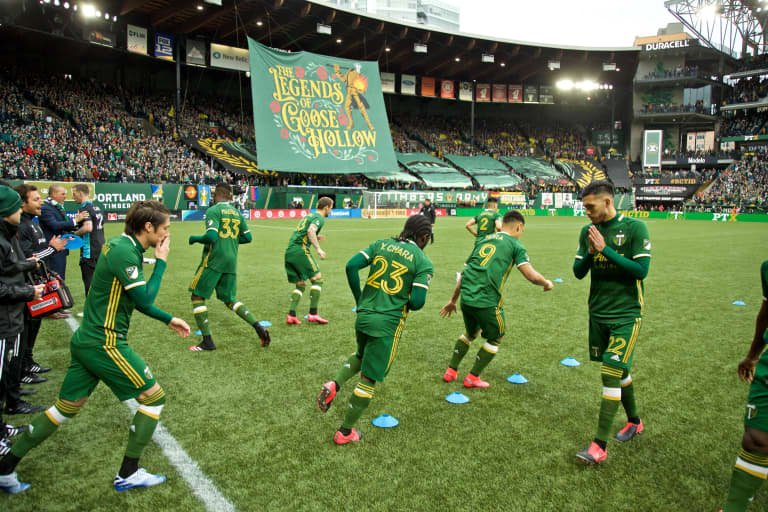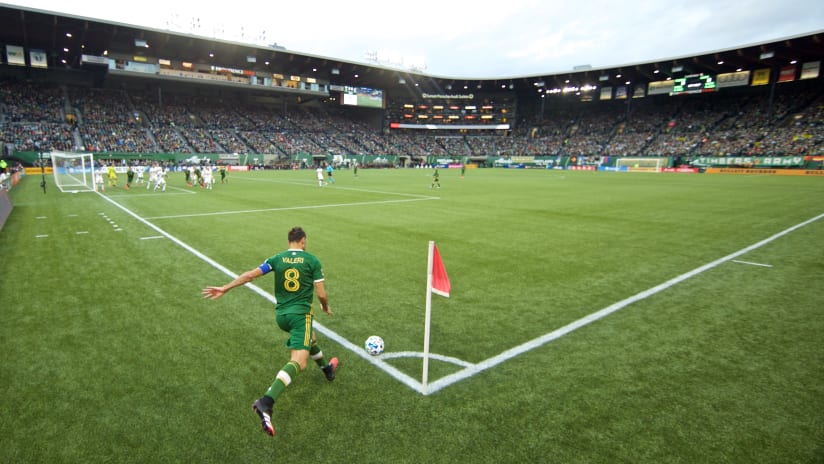PORTLAND, Ore. – Come the final whistle of the Portland Timbers’ first home game of the 2020 Major League Soccer season, the feeling was very much as it had been eight days before, when the team’s defensive struggles saw its preseason schedule close on a disappointing note. For the first half of Sunday’s game, those notes felt distant and potentially irrelevant, with promising performances in both attack and defense hinting last week’s disappointments may, in time, be forgotten.
Minnesota United FC would score three times in the second half, though, opening the scoring in the 51st minute and responding to their host’s equalizer with goals in the 76th and 78th. In a 3-1 defeat, the Timbers not only replicated the mistakes of their preseason but, with games starting to count, grew slightly more desperate for solutions.
“We have said for the past two years that we wanted to have a balanced schedule, play at home,” head coach Giovanni Savarese said, alluding to the prolonged road stretches that accompanied the starts of the 2018 and 2019 seasons. “We didn’t take advantage playing at home.
“We played a phenomenal first half, but this, right now, is the way this team is. I need to work more. I need to make sure that we’re able to do better, because to give up with goals in the second half after we were 1-1 is not what we want.”
There will be a bigger picture to 2020’s home opener, one that will cast Portland loss as the start of a trend, a wakeup call, or something less relevant. But beyond the game, there were reminders of the bigger picture around the Timbers, from the meaningful soccer in Portland’s March to the honoring of a legend recently lost. Though it was impossible not to carry the result’s disappointment away from the park, in time, it may be impossible to forget the return to normalcy in Goose Hollow, and an opening tifo which bore a part of the Timbers Army’s heart.
On the field, what carried forward
The two major questions that emerged around the Timbers this preseason: will the attack figure out how to break down deep-sitting opponents; and will the defense learn how to manage moments in transition without leaving themselves exposed?
Sunday’s answers on both front were clear and identical: No.
“We created many chances, had opportunities, but it is all on us,” Savarese said. “We gave the game away and credit to them, because they worked more than we did in the second half. The found the reward that they wanted and that they worked for in the second half.
“We cannot be this team of two halves. We need to be a little more consistent. The first half is the team we need to be, but it needs to be complete in the match.”
What we saw from the Timbers’ attack is probably worth a deeper discussion, one that will take more space than is appropriate for a story one hour post-whistle. In the first half, though, the Timbers posed a number of different threats, from Yimmi Chara’s speed behind the defense to their ability to build down the right, to the areas that opened in front of Minnesota’s line. Though Portland didn’t score, they seemed to meet every Minnesota adjustment with a new threat, offering variety that we rarely saw last season.
Ultimately, though, the Timbers failed to score an open-play goal, with Diego Valeri getting his team on the scoresheet from the penalty spot. Perhaps that fact understates the quality of Portland’s play, but it perfectly describes the reality on the scoreboard.
“I think the result doesn’t reflect what it was, the way of the game,” Valeri said. “We have to figure out how to score first, manage the game, and then to be more efficient when we create chances.”
The Timbers didn’t score enough, a deficiency that speaks to the team’s defending as well as its attacking. The team had committed too many players forward ahead of Kevin Molino’s 51st-minute opener and, as was often seen in the preseason, failed cover the far post on Ethan Finlay’s 76th-minute cross, headed home by Luis Amarilla. Ahead of Molino’s 78th-minute volley from the middle of the penalty box, defenders let eyes for the ball drag them out of position, allowing Minnesota to put the game out of reach.
“Just an unbalanced team that allowed moments to the other team to be able to be dangerous,” is how Savarese described his team. “[The team] created those moments in which you have to sacrifice defensively and you leave things to hope. Sometimes hope is not enough.
“Those moments, we need to be in control the way we did in the first half. It was unfortunate because, as I said, the team did very, very well. In the second half, unfortunately, we allowed those moments and then the game changed completely because now when you have to go and search the game and look for the game you open yourself to the situations we saw in the second half.”
Off the field
In the buildup to Sunday’s game, after gates opened and the North End began to swell, it was hard not to spare a thought for last year, when so much about games at Providence Park felt off. It wasn’t just that the team had its entire home cast into five months instead of eight, or that so many felt exhausted come the season’s close. It was that the fans and organization were at odds for much of the campaign, each pained in different ways by the league’s new fan code of conduct. That code has been changed this year, but nine months ago, it bred contention within the culture.
None of that contention existed on Sunday. As drums started to sound from the TA, and explosions of noise greeted the players’ first moments on the field, you remembered what life was like two years ago, before those cheers existed within a divisive context. You felt that the normalcy so many had talked about regarding the 2020 season, a word applied to the team’s schedule, also applied to the environment in Goose Hollow. From the moment supporters began claiming seats in general admission, the feel of Providence Park was back on course.
Perhaps the best example of that was how the fans honored Jimmy Conway. One of five members of the team’s Ring of Honor, the former Timber passed away on February 14 and was duly observed during the preseason. Still, as part of their annual tradition of a first-game tifo, the Timbers Army decided to supply a further honor, with a “Legends of Goose Hollow” display flying above, in the stadium’s northeast corner, Conway’s hanging image. Next to that display was another, saying simply “Players come and go; Legends are forever.”

Photo: Craig Mitchelldyer / Portland Timbers
The moment was a reminder of what all share by being part of the culture. Results are always a constant – the metronomic tick that paces each season – but around those wins and losses and, the things that differentiate start to grow. As they’re found, picked out and fostered, they become defining parts of the community – the things new fans will be drawn to. Over seasons, decades and generations, memories become foundations, and foundations become culture.
Jimmy Conway was part of that, as are the traditions with which he’s honored. As are those who see those traditions through. After a tumultuous 2019, it was apt that 2020 started with those traditions, as well as a reminder: there are some things that transcend results; and those things keep us coming to the park.












